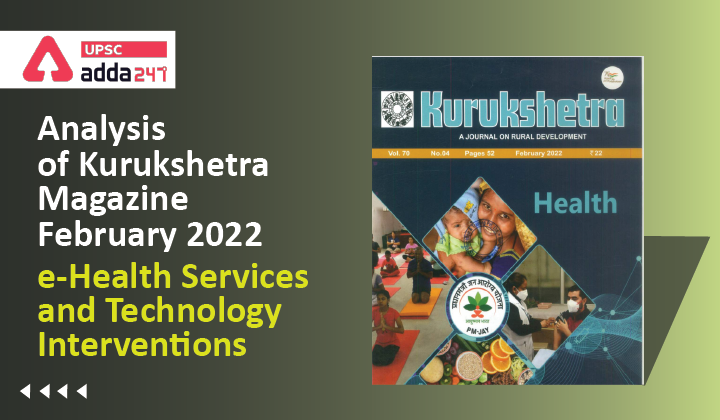Analysis of Kurukshetra Magazine: e-Health Services and Technology Interventions
Relevance
”GS 2: Government Policies & Interventions, Central Sector Schemes”
”GS 3: Health, Human Resource”
Introduction
- After the advent of the COVID-19 pandemic across the world, e-health services have become increasingly useful.
- The government has undertaken the implementation of the National Telemedicine Network (NTN) that provides telemedicine services to the country’s most remote areas by upgrading existing government healthcare facilities in all states.
- This service aims to overcome existing challenges like the lack of specialists and inaccessibility of doctors in rural areas by using information technology in delivering healthcare services.
- The Government of India also manages the eSanjeevani portal, a doctor-to-patient telemedicine system under Ayushman Bharat Scheme. Through e-Sanjeevani OPD (Outpatient Delivery), any individual may seek medical advice and medication through audio and video.
About National Telemedicine Network (NTN)
- It has been envisaged to provide Telemedicine Services to the remote areas by upgrading existing Government Healthcare Facilities (MC, DH, SDH, PHC, and CHC) in States.
- Telemedicine nodes across India are being created interconnecting SDH/PHC/CHC, District Hospital and Medical College in every State for providing Citizen-centric services.
3 Key areas of e-Health as per WHO
- Delivery of health information and records, for both the professionals as well as the consumers.
- Using the power of information technology and e-commerce platforms to improve the public health infrastructure.
- Use of e-commerce and e-business practices in health management systems.
Popular e-Health Services
1. Telemedicine/Telehealth
It can be described as the remote delivery of healthcare services including medical examinations and consultations using telecommunication services.
2. mHealth (mobile health)
mHealth refers to the practice of medicine and welfare using mobile smart devices.
3. Electronic Health Records (EHR)
EHR is a systemised collection of patient history stored electronically that can be accessed across multiple formats.
4. Wearable Sensors
Wearable sensors refer to the health monitors which help in tracking an individual’s body functions like heart rate, sleep quality, oxygen levels, etc.
Advantages of e-Health
- Efficiency
- Reduction in cost
- Empowerment
- Better relations
- Equity
- Education
- Faster decision making
Some major trends in health in the post-COVID-19 world
Smartphones
These devices can be used to effectively operate digital technology to support healthcare facilities.
Big Data
Big data is expected to be a game-changer in this space by providing lower rate of medication errors.
Virtual Reality
Virtual Reality has already started making its mark in the digital health world by providing support in treating anxiety, post-traumatic stress and stroke, among others.
Wearables
With wearables tracking heart rate, exercise levels, sleep quality etc, these can play a key role in providing up to date monitoring of high-risk patients.
Artificial Intelligence (AI)
The power of artificial intelligence can be seen in areas such as precision medicine, medical imaging, drug discovery and genomics.
Blockchain
Blockchain technology has already been deployed to create digital versions of medical charts.
Conclusion
To empower citizens to participate in the improvement of healthcare service delivery by providing feedback on service quality, facilities etc. at hospitals and ultimately help establish a patient-driven, responsive and accountable healthcare system, e-Health system has been played a very important role in recent years and it’s future of health care system in the country.



 TSPSC Group 1 Question Paper 2024, Downl...
TSPSC Group 1 Question Paper 2024, Downl...
 TSPSC Group 1 Answer key 2024 Out, Downl...
TSPSC Group 1 Answer key 2024 Out, Downl...
 UPSC Prelims 2024 Question Paper, Downlo...
UPSC Prelims 2024 Question Paper, Downlo...





